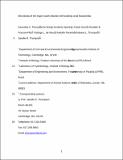Microbiota of the Major South Atlantic Reef Building Coral Mussismilia
Author(s)
Fernando, Samodha C.; Wang, Jia; Sparling, Kimberly M.; Garcia, Gizele D.; Francini-Filho, Ronaldo B.; de Moura, Rodrigo L.; Paranhos, Rodolfo; Thompson, Fabiano L.; Thompson, Janelle Renee; ... Show more Show less
Download248_2014_474_ReferencePDF.pdf (430.7Kb)
OPEN_ACCESS_POLICY
Open Access Policy
Creative Commons Attribution-Noncommercial-Share Alike
Terms of use
Metadata
Show full item recordAbstract
The Brazilian endemic scleractinian corals, genus Mussismilia, are among the main reef builders of the South Atlantic and are threatened by accelerating rates of disease. To better understand how holobiont microbial populations interact with corals during health and disease and to evaluate whether selective pressures in the holobiont or neutral assembly shape microbial composition, we have examined the microbiota structure of Mussismilia corals according to coral lineage, environment, and disease/health status. Microbiota of three Mussismilia species (Mussismilia harttii, Mussismilia hispida, and Mussismilia braziliensis) was compared using 16S rRNA pyrosequencing and clone library analysis of coral fragments. Analysis of biological triplicates per Mussismilia species and reef site allowed assessment of variability among Mussismilia species and between sites for M. braziliensis. From 173,487 V6 sequences, 6,733 coral- and 1,052 water-associated operational taxonomic units (OTUs) were observed. M. braziliensis microbiota was more similar across reefs than to other Mussismilia species microbiota from the same reef. Highly prevalent OTUs were more significantly structured by coral lineage and were enriched in Alpha- and Gammaproteobacteria. Bacterial OTUs from healthy corals were recovered from a M. braziliensis skeleton sample at twice the frequency of recovery from water or a diseased coral suggesting the skeleton is a significant habitat for microbial populations in the holobiont. Diseased corals were enriched with pathogens and opportunists (Vibrios, Bacteroidetes, Thalassomonas, and SRB). Our study examines for the first time intra- and inter-specific variability of microbiota across the genus Mussismilia. Changes in microbiota may be useful indicators of coral health and thus be a valuable tool for coral reef management and conservation.
Date issued
2014-09Department
Massachusetts Institute of Technology. Department of Civil and Environmental EngineeringJournal
Microbial Ecology
Publisher
Springer US
Citation
Fernando, Samodha C., Jia Wang, Kimberly Sparling, Gizele D. Garcia, Ronaldo B. Francini-Filho, Rodrigo L. de Moura, Rodolfo Paranhos, Fabiano L. Thompson, and Janelle R. Thompson. “Microbiota of the Major South Atlantic Reef Building Coral Mussismilia.” Microbial Ecology 69, no. 2 (September 12, 2014): 267–280.
Version: Author's final manuscript
ISSN
0095-3628
1432-184X